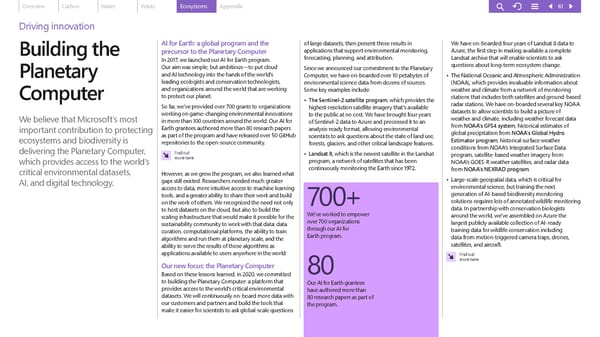Overview Carbon Water Waste Ecosystems Appendix 61 Driving innovation AI for Earth: a global program and the of large datasets, then present those results in We have on-boarded four years of Landsat 8 data to Building the precursor to the Planetary Computer applications that support environmental monitoring, Azure, the first step in making available a complete In 2017, we launched our AI for Earth program. forecasting, planning, and attribution. Landsat archive that will enable scientists to ask Our aim was simple, but ambitious—to put cloud Since we announced our commitment to the Planetary questions about long-term ecosystem change. Planetary and AI technology into the hands of the world’s Computer, we have on-boarded over 10 petabytes of • The National Oceanic and Atmospheric Administration leading ecologists and conservation technologists, environmental science data from dozens of sources. (NOAA), which provides invaluable information about and organizations around the world that are working Some key examples include: weather and climate from a network of monitoring Computer to protect our planet. • The Sentinel-2 satellite program, which provides the stations that includes both satellites and ground-based So far, we’ve provided over 700 grants to organizations highest-resolution satellite imagery that’s available radar stations. We have on-boarded several key NOAA working on game-changing environmental innovations to the public at no cost. We have brought four years datasets to allow scientists to build a picture of We believe that Microsoft’s most in more than 100 countries around the world. Our AI for of Sentinel-2 data to Azure and processed it to an weather and climate, including weather forecast data important contribution to protecting Earth grantees authored more than 80 research papers analysis-ready format, allowing environmental from NOAA’s GFS4 system, historical estimates of as part of the program and have released over 50 GitHub scientists to ask questions about the state of land use, global precipitation from NOAA’s Global Hydro ecosystems and biodiversity is repositories to the open-source community. forests, glaciers, and other critical landscape features. Estimator program, historical surface weather delivering the Planetary Computer, conditions from NOAA’s Integrated Surface Data Find out • Landsat 8, which is the newest satellite in the Landsat program, satellite-based weather imagery from which provides access to the world’s more here program, a network of satellites that has been NOAA’s GOES-R weather satellites, and radar data critical environmental datasets, However, as we grew the program, we also learned what continuously monitoring the Earth since 1972. from NOAA’s NEXRAD program. AI, and digital technology. gaps still existed. Researchers needed much greater • Large-scale geospatial data, which is critical for access to data, more intuitive access to machine learning environmental science, but training the next tools, and a greater ability to share their work and build generation of AI-based biodiversity monitoring on the work of others. We recognized the need not only 700+ solutions requires lots of annotated wildlife monitoring to host datasets on the cloud, but also to build the data. In partnership with conservation biologists scaling infrastructure that would make it possible for the We’ve worked to empower around the world, we’ve assembled on Azure the sustainability community to work with that data: data over 700 organizations largest publicly available collection of AI-ready curation, computational platforms, the ability to train through our AI for training data for wildlife conservation including algorithms and run them at planetary scale, and the Earth program. data from motion-triggered camera traps, drones, ability to serve the results of those algorithms as satellites, and aircraft. applications available to users anywhere in the world. Find out more here Our new focus: the Planetary Computer 80 Based on these lessons learned, in 2020, we committed to building the Planetary Computer: a platform that Our AI for Earth grantees provides access to the world’s critical environmental have authored more than datasets. We will continuously on-board more data with 80 research papers as part of our customers and partners and build the tools that the program. make it easier for scientists to ask global-scale questions
 Microsoft Environmental Sustainability Report 2020 Page 60 Page 62
Microsoft Environmental Sustainability Report 2020 Page 60 Page 62